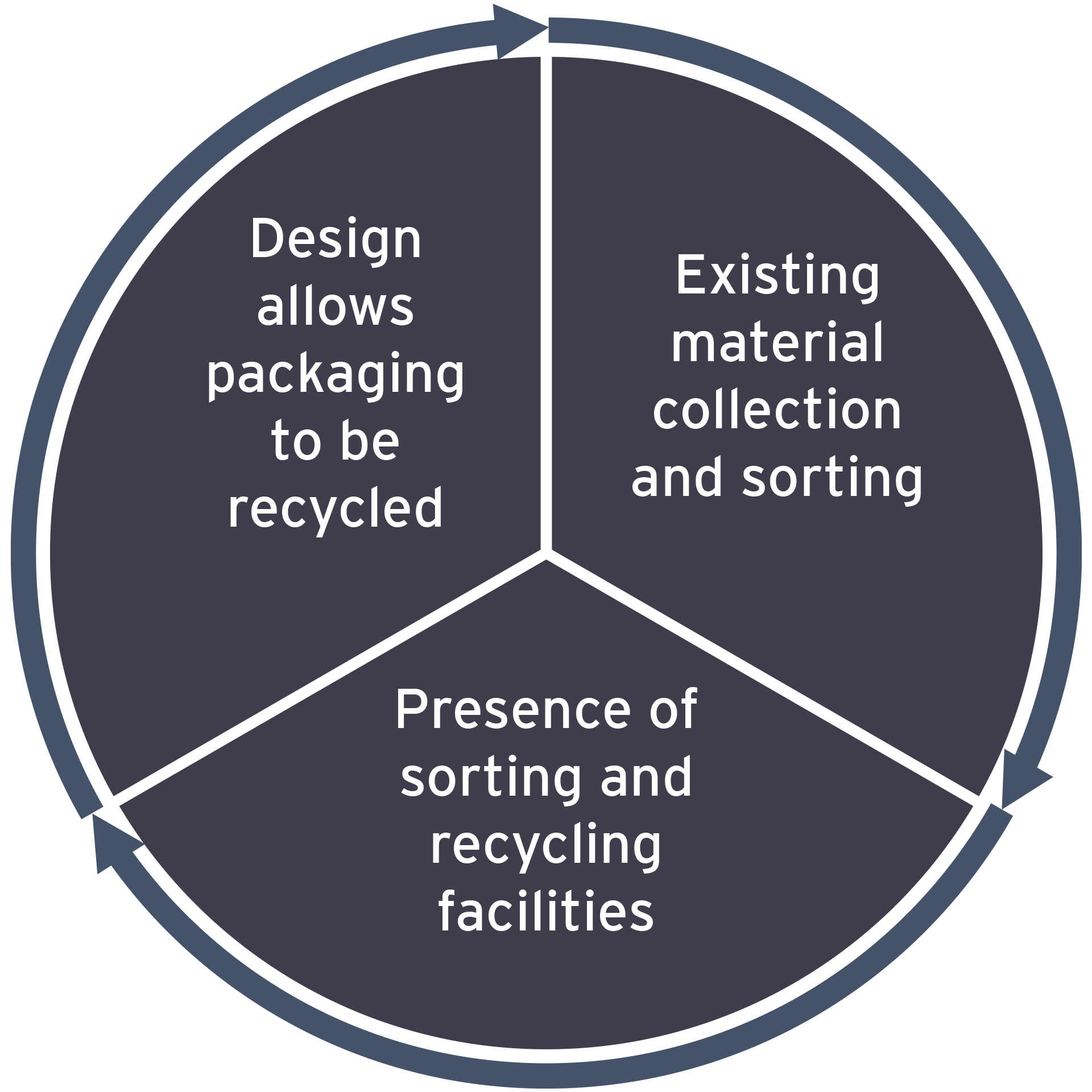EY refers to the global organization, and may refer to one or more, of the member firms of Ernst & Young Global Limited, each of which is a separate legal entity. Ernst & Young Global Limited, a UK company limited by guarantee, does not provide services to clients.

Soon, recyclability will be a minimum requirement for all packaging. Producers should take action today and assess their packaging portfolio.
In brief
- By 2030, all packaging placed on the EU market has to be reusable, recyclable in an economically viable way, or compostable.
- Where does this come from and what will be the impact? What role do producers have to play? What is the definition of “recyclable” and when is something economically viable?
By 2030, all packaging placed on the EU market has to be reusable, recyclable in an economically viable way, or compostable for specific cases, according to the New Circular Economy Action Plan. Companies need to assess their packaging portfolio towards the requirements of this deadline and should start now. To ensure that packaging is recyclable in an economically viable way, they should make sure that their packaging and their development strategy are in line with technical standards and the collection, sorting and recycling infrastructure of different countries.
State of play | Waste and recycling rate for packaging within the EU
Despite improvements in recycling over the past decade, the generation of plastic packaging waste is still massive and is increasing. In 2020, 9.7 million tons1 were incinerated or landfilled, representing the equivalent of 27 times the weight of the Empire State Building or 185 times the Titanic.
Therefore, plastic packaging waste is a hot topic on the political agenda to shift towards a more sustainable society.
What is recyclability and what can the producers do about it
To be considered recyclable, packaging should meet the following conditions:

This means that recyclability is based on a twofold logic that can be assessed by the producers: packaging is recyclable if the technical and logistical criteria are met.
Technically, producers should make sure that the materials used in the packaging components meet the technical standards (e.g. from the Producer Responsibility Organization of the country, industry guidelines and national legislations) regarding the choice of composition, inks, additives, density, etc. before putting packaging on the market. For example, design for recycling implies avoiding multilayer composite materials that cannot easily be separated from each other, or not using dark and opaque colors, favoring EuPIA-compliant printing inks, etc.
Packaging also needs to be recyclable logistically, meaning that collection and sorting or processing infrastructure needs to be in place that enables industrial-scale recycling in the country.
Today, there is still a lack of a common EU claim on recyclable packaging, essentially due to the differences between member states in terms of level of infrastructure for collection, sorting and recycling and the associated technical standards. This means that certain packaging can be recycled in one member state but not in another, because of the non-harmonization in recycling capabilities. For example, PET trays or PP packaging are recyclable as their recovery systems allow the full reprocessing of the resin. However, it may be deemed non-recyclable in a country lacking the necessary structures to permit proper collection, sorting and/or recycling. Therefore, if the packaging is classified as recyclable, this refers to a clearly defined geographical zone and application period.
Accordingly, packaging could not be claimed recyclable in a country where it does not meet the local standards and/or it is not separately collected for recycling. Producers should indeed be careful with their recyclability claims and verify the local technical and logistical criteria to avoid unintentional greenwashing. In some countries, this verification is already a compliance matter due to the mandatory labeling of sorting instructions and/or recyclability (e.g. in France and Italy). Soon, it is expected that such logos will be mandatory across the entire EU.
The EU agenda on packaging eco-design for recyclability
The New Circular Economy Action Plan from the EU sets an ambitious target: by 2030, all packaging on the market must be reusable, compostable in specific cases, or recyclable in an economically viable way. If none of these conditions are met, the packaging will be banned. To reach this objective, the European Commission is currently working on various initiatives to create a new momentum for the legislative framework.
For example, in the frame of the revision of the Packaging and Packaging Waste Directive, guidelines on design for recycling will be published and packaging type and materials will be ranked into recycling classes. Eco-modulation principles based on those classes are likely to be imposed as well, creating more incentives to switch to packaging design with a high recyclability level.
Read more about EPR and its complexities for producers.
Compliance and strategy
A sound circular packaging strategy and its implementation is a must for all companies putting packaging on the European market, not only from a branding and market perspective, but soon for compliance purposes as well, with the new upcoming legislation.
Soon, recyclability will be a minimum requirement for all packaging, and producers should already take action to assess their packaging portfolio. Making packaging recyclable is already part of the compliance journey, and cannot remain a strategy only.
Improving recyclability is a must, but only the first step of a bigger objective: reducing waste and carbon footprint.
How EY can help
Redesign your packaging strategy in accordance with existing and upcoming legislation.
Read moreService Leader
-
 Sophie Chirez
Sophie ChirezEY Belgium Climate Change and Sustainability Executive Director
Newsletters EY Belgium
Subscribe to one of our newsletters and stay up to date of our latest news, insights, events or more.
Summary
To ensure the EU 2030 obligations are met, companies should make sure their packaging is recyclable. A sound circular packaging strategy and its implementation is a must for all companies putting packaging on the European market.


